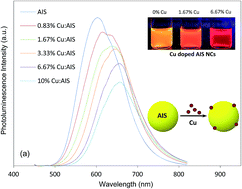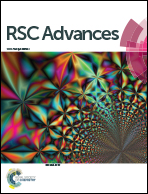Preparation of photoluminescence tunable Cu-doped AgInS2 and AgInS2/ZnS nanocrystals and their application as cellular imaging probes†
Abstract
In this work, high-quality Cu doped AIS and AIS/ZnS NCs have been first synthesized via a surface doping approach. By varying the Cu doping concentrations, Cu doped AIS NCs exhibit a photoluminescence red-shift from around 600 nm to 660 nm with a decrease of quantum yield from around 30% to 20%. After ZnS coating or zinc etching on the Cu doped AIS NCs, Cu doped AIS/ZnS NCs present photoluminescence peaks from around 570 nm to 610 nm and high quantum yields in the range of 50–60%. Moreover, it is found that Cu doping can prolong the photoluminescence lifetime of NCs, and the average photoluminescence lifetime of Cu doped AIS and AIS/ZnS NCs is in the range of 300–500 ns. The resultant Cu doped AIS/ZnS NCs were further encapsulated with amphiphilic polymers and used as biocompatible photoluminescence probes in cellular imaging. The cellular imaging study shows that peptide-conjugated probes can specifically target U-87 brain tumor cells and thus they can be applied to the detection of endogenous targets expressed on brain tumor cells.


 Please wait while we load your content...
Please wait while we load your content...